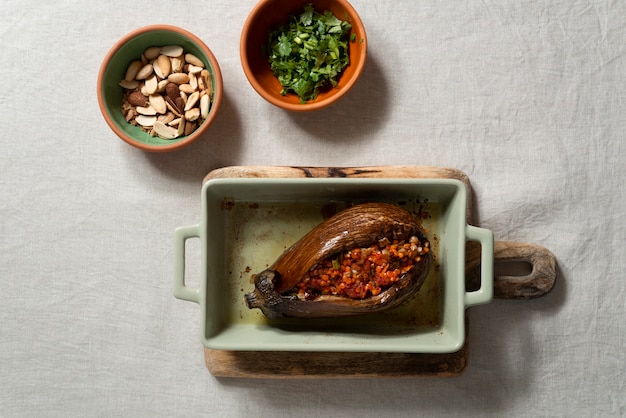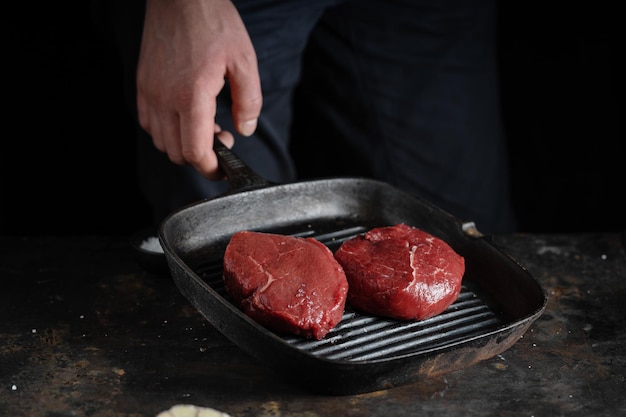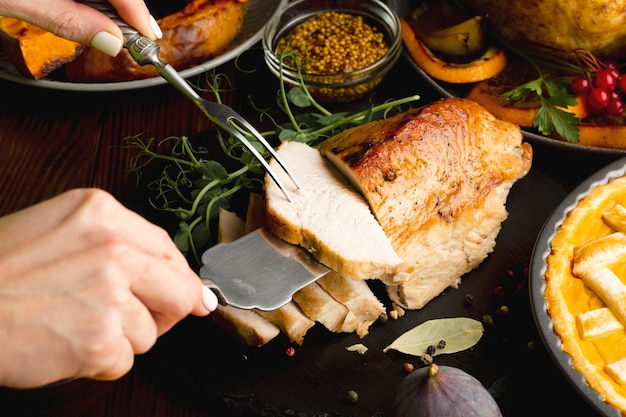Let's be honest, filet mignon is the ultimate steak experience. It's that gloriously tender, buttery-soft cut that melts in your mouth. But, we've all been there, staring at that beautiful piece of meat in the supermarket, wondering if we can really pull off that restaurant-quality steak at home. Well, I'm here to tell you, you absolutely can! And I'm not just talking about a passable attempt, I'm talking about a truly jaw-dropping filet mignon, cooked to perfection, right in your own kitchen.
Over the years, I’ve experimented with countless methods and recipes, and I’ve finally cracked the code. Now, I can whip up a filet mignon that rivals any fancy steakhouse. And the best part is, it’s actually quite simple. Trust me, even if you’re a total cooking newbie, you can nail this.
In this guide, we’ll cover everything you need to know, from choosing the right cut of meat to mastering the oven technique. I'll even share some of my favourite side dishes and sauces, because let's be honest, a perfect steak deserves the perfect accompaniments.
(Part 1) The Cut: Choosing Your Filet Mignon

The Importance of Quality
We're talking about a premium cut of meat here, so it's worth splashing out on the best quality you can afford. You'll thank yourself later. It's all about marbling, that lovely network of fat throughout the meat. The more marbling, the more flavour and tenderness. Look for a piece of meat that's bright red, not dull or brown. This indicates freshness and good quality.
Filet Mignon vs. Tenderloin: What's the Difference?
You might see these terms used interchangeably, but there's a slight difference. The tenderloin is the whole muscle, and the filet mignon is a specific cut from the tenderloin. You’ll often find filet mignon labelled as “center cut” or “mid-section” which means it’s the most tender part. But, honestly, both are fantastic, and it’s really down to your personal preference.
Thickness: The Goldilocks Zone
Aim for a thickness of about 1-1.5 inches. This will ensure that the steak cooks evenly without drying out. If you find a thicker piece, you can always butterfly it (cut it almost all the way through horizontally) to create a thinner steak.
(Part 2) Preparing for Perfection: The Essentials

Let’s be honest, prepping the steak is half the battle, but it doesn’t have to be complicated. Just a few simple steps will make all the difference.
Pat It Dry: A Crucial First Step
Firstly, pat the steak dry with paper towels. This will help to create a nice sear and prevent any steam build-up, which can make the steak tough. A dry surface allows for a crispier crust and better browning.
Salt It Right: The Importance of Timing
Salt the steak generously on all sides. Now, this is where things get interesting. You might be tempted to salt the steak right away, but trust me, it’s better to do it 30 minutes to an hour before cooking. This gives the salt time to draw out moisture and then reabsorb it, creating a more flavourful and juicy steak. The salt essentially "brines" the steak, allowing it to retain more moisture during cooking.
Don’t Overdo the Pepper:
Unless you’re into a seriously peppery steak, use pepper sparingly. A light dusting is all you need. You want the flavour of the steak to shine through, not be overpowered by spices. A little black pepper goes a long way, enhancing the natural flavour without overshadowing it.
(Part 3) The Oven Technique: Your Steak’s New Best Friend

Ok, so the oven is your trusty sidekick for creating a perfect filet mignon. It’s consistent, it’s easy, and it lets you focus on other things. We’re going for a combination of searing and slow cooking, for that juicy, flavour-packed result.
Preheating is Key: The First Step
Preheat your oven to 400 degrees Fahrenheit (200 degrees Celsius). This will make sure the oven is nice and hot for searing. A hot oven is essential for creating that beautiful crust and ensuring even cooking.
Searing the Steak: The Secret to Delicious Crust
Heat a heavy-bottomed skillet or cast iron pan over high heat. Now, here's the thing: you want the pan smoking hot. Add a little bit of oil (I like avocado oil for its high smoke point) and sear the steak for 2-3 minutes per side. It’s all about that beautiful golden-brown crust. It’s a game-changer. Searing creates a flavorful crust, sealing in juices and adding depth of flavor.
Transfer to the Oven: Patience is Virtue
Carefully transfer the seared steak to a baking sheet. This is where the oven takes over. Bake for 10-15 minutes for medium-rare, 15-20 minutes for medium, and 20-25 minutes for medium-well. But check the internal temperature with a meat thermometer to be sure. You want it to reach your desired doneness. The oven provides gentle heat, allowing the steak to cook evenly throughout while retaining moisture.
(Part 4) The Rest: Patience is a Virtue
The final step is crucial, and it’s all about patience. Let the steak rest for 10-15 minutes before slicing and serving. This allows the juices to redistribute, resulting in a steak that’s both tender and juicy. Don’t skip this step! Resting is a critical step in achieving that perfect texture and juicy outcome.
(Part 5) The Internal Temperature: Understanding Your Steak's Doneness
So, you’ve done all the hard work, and now it’s time to figure out if your steak is done. Here’s the breakdown:
Internal Temperatures:
Here’s a handy table to guide you:
| Doneness | Internal Temperature (Fahrenheit) |
|---|---|
| Rare | 125-130 degrees |
| Medium-rare | 130-135 degrees |
| Medium | 140-145 degrees |
| Medium-well | 150-155 degrees |
| Well-done | 160 degrees and above |
If you’re a newbie, err on the side of medium-rare. You can always cook it longer if you find it's not quite done enough. But you can’t un-cook a well-done steak. It's always better to start with a slightly rare steak and cook it further if needed.
Using a Meat Thermometer: Your Steak's Best Friend
To get the most accurate reading, insert the thermometer into the thickest part of the steak, making sure it doesn’t touch any bone. A meat thermometer is essential for ensuring that your steak is cooked to your liking and safe to eat.
(Part 6) The Finishing Touches: Elevate Your Steak Game
Ok, so we’ve got a perfectly cooked filet mignon. Let’s take it to the next level with some finishing touches.
Butter: The Magic Ingredient
As the steak rests, add a knob of butter to the hot pan you used for searing. Once it’s melted, use a spoon to baste the steak with the buttery goodness. This will add another layer of flavour and moisture. The melted butter creates a flavorful glaze and enhances the steak's natural juices.
Herbs and Spices: A Touch of Magic
Don’t be afraid to get creative. A sprinkle of fresh herbs like rosemary, thyme, or parsley adds a lovely aroma. You can also add a pinch of garlic powder or onion powder for extra flavour. Fresh herbs and spices add a touch of elegance and complexity to the flavor profile of your steak.
Sauce: The Perfect Accompaniment
A great sauce can elevate your steak to another level. Here are some of my favourite options:
- Béarnaise Sauce: The classic pairing for filet mignon. It’s rich, creamy, and tangy, and it complements the richness of the steak perfectly. The egg yolks and white wine vinegar in béarnaise sauce create a luxurious and tangy sauce that pairs perfectly with the rich flavor of filet mignon.
- Red Wine Sauce: A simple but delicious sauce made with red wine, shallots, and herbs. It’s the perfect choice for a steak cooked to medium or medium-well. Red wine sauce adds a deep, earthy flavor to the steak, enhancing its natural richness.
- Mushroom Sauce: Earthy and flavorful, this sauce is made with sautéed mushrooms, cream, and herbs. It’s a great choice for those who love mushrooms. Mushroom sauce provides a savory and umami-rich accompaniment to the steak, adding another layer of complexity.
- Garlic Butter Sauce: Quick and easy, this sauce is simply melted butter with a generous amount of garlic. It’s perfect for a simple, yet flavorful steak. Garlic butter sauce is a simple and flavorful option that provides a rich and aromatic sauce to enhance the steak.
(Part 7) The Side Dishes: Creating a Well-Rounded Meal
Let’s face it, a steak is only as good as its side dishes. Here are some of my go-to’s:
- Roasted Vegetables: A classic and versatile choice. Try roasting asparagus, broccoli, Brussels sprouts, or even carrots and potatoes. Roasted vegetables provide a vibrant and flavorful contrast to the richness of the steak.
- mashed potatoes: Creamy, comforting, and the perfect companion to a rich, flavorful steak. Mashed potatoes are a classic comfort food that pairs beautifully with the richness of filet mignon.
- Creamy Polenta: A slightly more adventurous option, polenta is a hearty and delicious side dish that pairs well with steak. Polenta provides a creamy and hearty base that complements the richness of the steak.
- Green Salad: A light and refreshing counterpoint to the richness of the steak. Choose a mix of greens, add some fresh herbs, and a simple vinaigrette dressing. A green salad provides a refreshing contrast to the richness of the steak, cleansing the palate and enhancing the overall dining experience.
(Part 8) The Final Touches: Presentation Matters
Ok, we’re almost there! Let’s make sure your steak looks as amazing as it tastes.
Slicing It Up: The Right Way to Cut
Slice the steak against the grain, which means cutting perpendicular to the muscle fibers. This will make the steak more tender and easier to chew. Slicing against the grain allows for more even bites and a softer texture, enhancing the overall eating experience.
Plating Up: A Feast for the Eyes
Arrange the steak slices on a plate with your chosen side dishes. Add a drizzle of sauce, a sprinkle of fresh herbs, and a few extra finishing touches, like a sprig of rosemary or a lemon wedge. Remember, presentation matters. A well-presented steak is not only visually appealing but also enhances the dining experience.
FAQs
1. Can I use a different cut of meat?
Absolutely! While filet mignon is the king of tenderness, other cuts like ribeye, strip steak, or even a thick-cut new york strip can be cooked in the oven using this method. Just adjust the cooking time based on the thickness of the cut. Different cuts of meat have unique flavors and textures, allowing you to experiment and discover new favorites.
2. Can I freeze the steak before cooking?
It’s best to cook your steak fresh, but if you need to freeze it, wrap it tightly in plastic wrap and freeze for up to 3 months. Thaw it in the refrigerator overnight before cooking. Freezing can affect the texture of the meat, but it can be a convenient option if you need to store the steak for a longer period.
3. What if my steak is overcooked?
Don’t despair! It's not the end of the world. If your steak is overcooked, it might be a bit dry, but you can still enjoy it. Try adding a rich sauce or a creamy topping to help compensate. Overcooked steak can still be salvaged by adding flavorful sauces or toppings to mask the dryness.
4. How can I make my steak extra juicy?
In addition to the tips already mentioned, you can try brining the steak before cooking. Soaking it in a salt-water solution for a few hours can help to lock in moisture and make the steak extra tender and juicy. Brining is a technique that helps retain moisture and tenderness, resulting in a more juicy steak.
5. Can I use a grill instead of the oven?
Of course! Grilling is a great way to cook filet mignon. Just make sure the grill is hot and use a meat thermometer to check for doneness. Grilling adds a smoky flavor and char to the steak, offering a different culinary experience.
And there you have it! The perfect guide to cooking filet mignon in the oven. Now go forth and impress your friends and family with your amazing culinary skills.
Remember, cooking a perfect filet mignon is all about confidence and mastering the basics. Don't be afraid to experiment and have fun in the kitchen! Enjoy!
Everyone is watching

Corn on the Cob: The Ultimate Guide to Perfectly Cooked Ears
Healthy MealsAh, corn on the cob. Just the name evokes images of sunny days, barbecues, and that sweet, juicy flavour that ...

Scallops: The Ultimate Guide to Perfect Cooking
Healthy MealsAh, scallops. Those delicate, sweet, and utterly delicious morsels of the sea. They hold a special place in my...

Spaghetti Squash: The Ultimate Guide to Cooking and Serving
Healthy MealsRemember that time you saw spaghetti squash at the supermarket, looking all bumpy and strange, and thought, "W...

Salmon Cooking Times: Perfect Guide for Every Recipe
Healthy MealsLet me tell you, cooking salmon is an art form. It's all about getting that perfect balance: juicy and tender,...

Ham Cooking Time: How Long to Bake, Smoke, or Boil a Delicious Ham
Healthy MealsAh, ham. It's a classic, isn't it? A real crowd-pleaser, especially around holidays. And when done right, it'...
